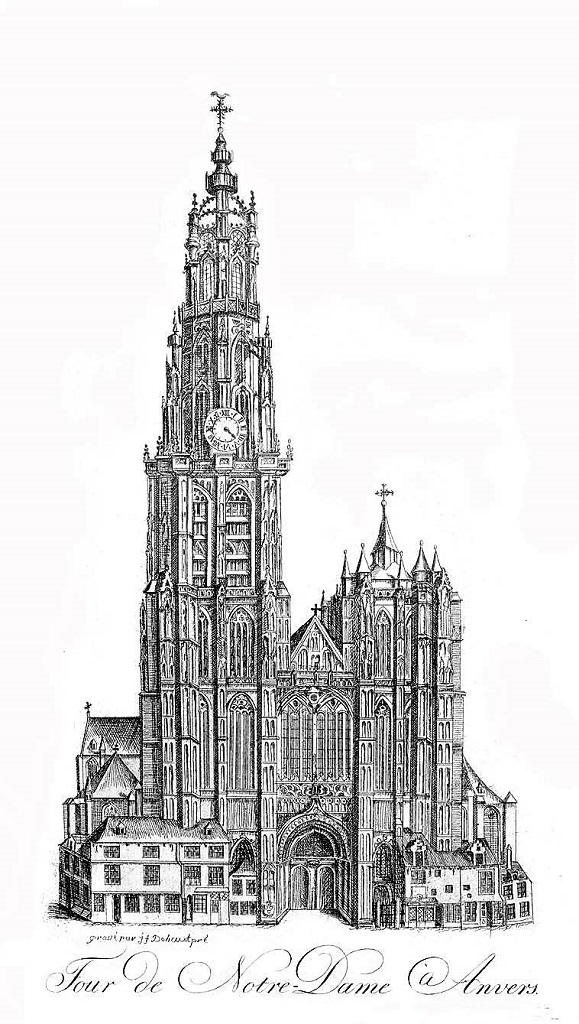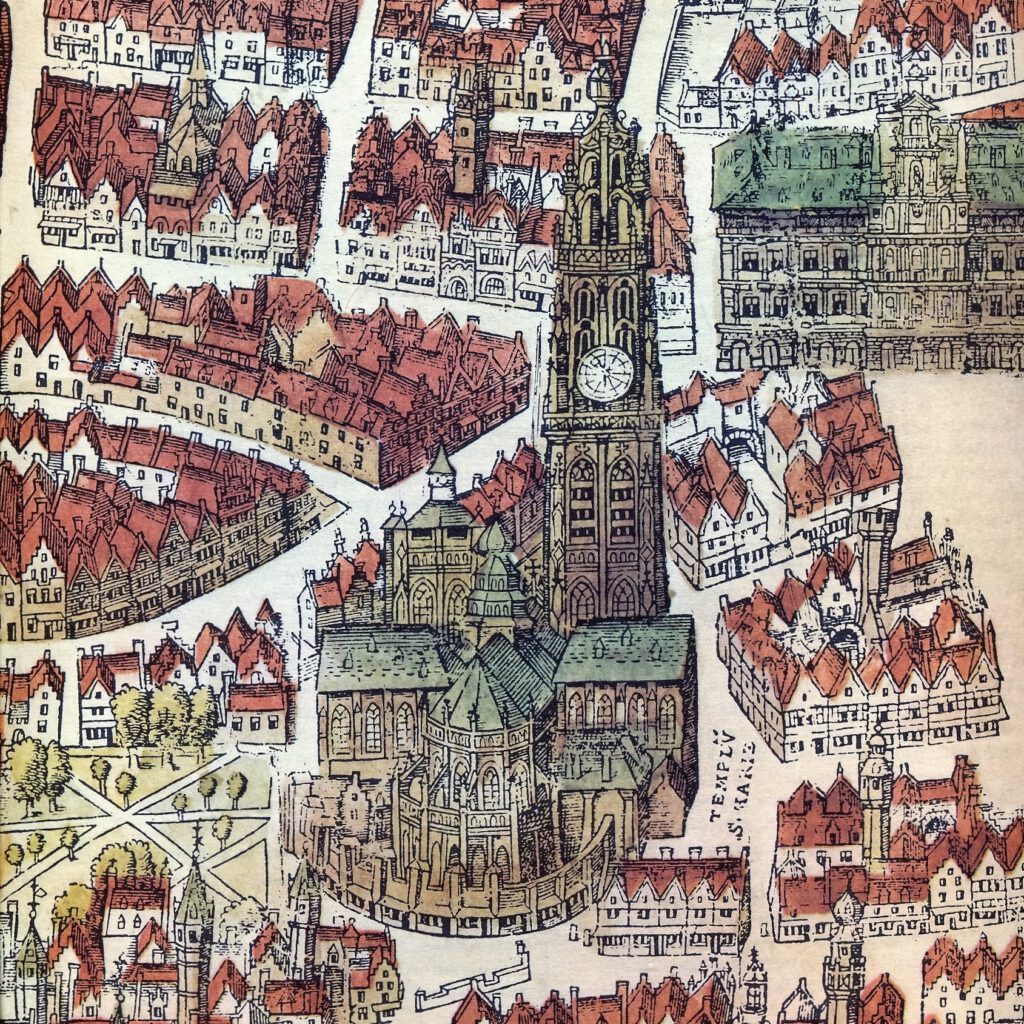The Our Lady’s Cathedral of Antwerp, a revelation.
Introduction
Dear reader,
No doubt Our Lady’s CathedralThe main church of a diocese, where the bishop’s seat is. is the most respectable monument in Antwerp. The elegant Our Lady’s spire may well be the most successful Gothic tower ever and is the pride and symbol of Antwerp. The space of the largest Gothic church in the Low Countries is impressive at first sight. The wooden Renaissance skylight, which is unique in its style, is a more hidden highlight. Because of the world famous paintings by Rubens this church has become one of the most important touristic attractions in the country. The descent from the cross is observed as an icon of Rubens and of Baroque painting. If you are looking for a good example of neo-Gothic redecoration and refurnishing this is the place to be.
Still this book does not want to be a traditional guidebook that only focuses on the highlights or mentions all the objects of interest one by one encyclopaedically. What you will find in the following pages is the disclosure of the cathedral. Its functions and history, its architecture and treasures of art will tell you the stories of people’s ups and downs. There is no church that is so interwoven with the story of the city; even the consequences of the evolution of the current of the river Scheldt can be read from the level of the floor. For centuries this church used to be a mirror of the urban society in that the crafts and guilds were represented in it by private altars. Their decorations allow us to approach the stories of the ‘working class’. Moreover it was the workers’ organizations that determined the successive extensions of the church, which resulted in the astonishing megalomaniac, but never finished dream of the New Work (‘Nieuwe Werck’). It is also surprising to see the many socio-cultural institutions that found their origin in this church. These include care of the sick, the poor and the lonesome, education, singing schools and libraries. The black pages of history were a result of ideological quarrels, of which some were more furious than others. Also within the own Catholic tradition there have been differences in taste, of which the results can still be seen. One could even wonder if Luigi Guicciardini, who in 1567 applauded the cathedral as a very large and costly church, wonderfully decorated all over (‘een seer groote en costelijcke kercke, heerlijk over al verciert’), would still recognize it straight away in its present bareness.
To disclose the full story of this church in one book however is an insurmountable task. Did you know that a ‘SaintThis is a title that the Church bestows on a deceased person who has lived a particularly righteous and faithful life. In the Roman Catholic and Orthodox Church, saints may be venerated (not worshipped). Several saints are also martyrs. Valentine’s’ guided tour about love, loyalty and marriage customs takes two hours in this church. This is why we do not deal with the many works of art that were destroyed or have ended up in museums and we confine ourselves to the patrimony that is still present. But if you are inquisitive and wonder why the Northern tower, which was never ‘123 metres’ tall, still gave the impression of being taller, and why the Southern tower has remained short, why there is a rooster on the tower and why there is a wood grouse on the pulpit, how the canons provided their library with the daylight needed or for which wine people preferred going to inns you will find answers in this book and to many more questions.
Religious art was never created to be objects of art, but to enthral humans into a spiritual and aesthetic experience. Besides a work of art seldom stands on its own. It is part of the religious perception of a community, whose identity and artistic expression are a result of tradition. This goes as much for a monumental altarThe altar is the central piece of furniture used in the Eucharist. Originally, an altar used to be a sacrificial table. This fits in with the theological view that Jesus sacrificed himself, through his death on the cross, to redeem mankind, as symbolically depicted in the painting “The Adoration of the Lamb” by the Van Eyck brothers. In modern times the altar is often described as “the table of the Lord”. Here the altar refers to the table at which Jesus and his disciples were seated at the institution of the Eucharist during the Last Supper. Just as Jesus and his disciples did then, the priest and the faithful gather around this table with bread and wine. triptych by Rubens as for a less impressive painting above the mantelpiece in a gathering room. Art history is part of cultural history.
The cathedral connects us with what former generations emphasized in their Christian faith. But if an age-old cathedral wants to respect itself, it must not have relegated itself to a museum of antiquities. From the respect for tradition the cathedral wants to fulfil its pioneering work, in line with its mission ‘to inspire and stimulate reflection’, and so it also wants to be accessible for present-day man. This is why in this book, instead of shortly dealing with as many works of art as possible, we want to put them in their context as much as possible and stay with them longer to enjoy them: an aspect of pastoral service for tourists or would it be cooler to call it slow art? We hope this book may propagate and contribute to the cathedral’s mission. Even ‘if they (i.e. the disciples) keep silent’, Jesus says, ‘the stones will cry out’ (Lk. 19:40).
- Our Lady’s Cathedral
- History & Description
- Preface
- Introduction
- Historical context
- A centuries-long building history
- A cathedral never stands alone
- Our Lady’s spire
- The main portal
- Spatial effect
- Mary’s Assumption (C.Schut)
- Erection of the Cross (PP.Rubens)
- Descent of the Cross (PP.Rubens)
- The Resurrection (PP.Rubens)
- Mary’s Assumption (PP.Rubens)
- The high altar
- The collegial choir
- The bishop’s church
- The parish church
- The pulpit
- The confessionals
- Caring for the poor
- The Venerable chapel
- Mary’s chapel
- Corporations and guilds
- The ambulatory
- Funeral monuments
- Praise the Lord!
- Pull all stops: the organs
- Cross-bearer (J.Fabre)
- Bibliography



